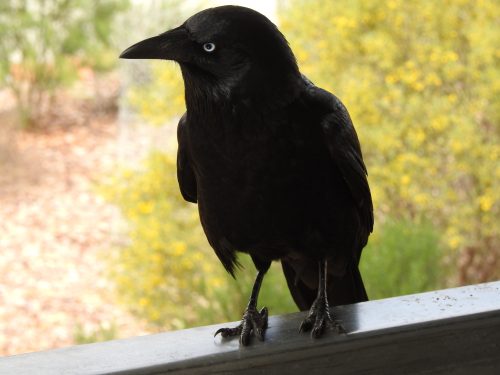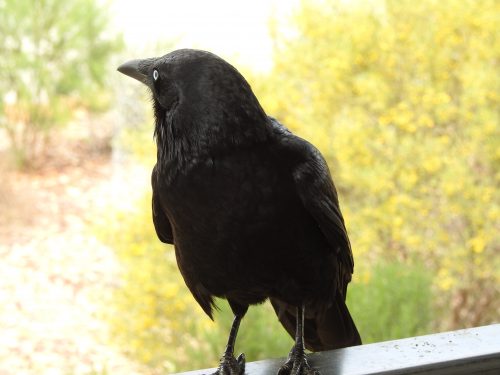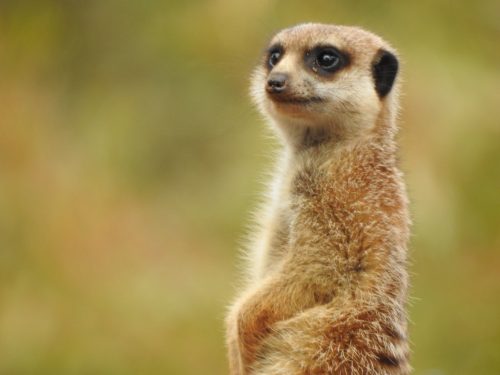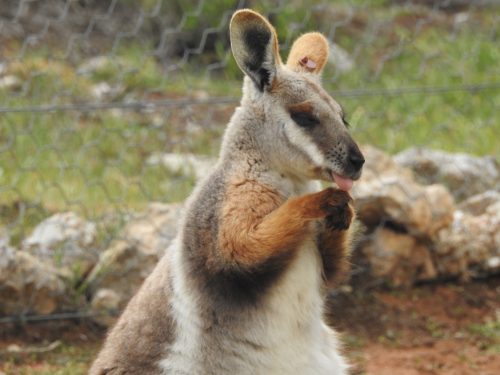A Cheeky Raven at Monarto Zoo
A few weeks ago my daughter suggested that we visit the Monarto Zoo. It had been about a year since my last visit which is rather poor of me because it is only a ten-minute drive from my home in Murray Bridge, South Australia. And I am a member so I can enter whenever I please at no cost. Monarto Zoo is a part of the Adelaide Zoo which I also must visit again soon.
Before we went on the guided bus tour of the open range zoo we decided to buy our lunch from the cafe in the Visitor Centre. We found a suitable table overlooking the garden and before we had even started eating, one of the local Little Ravens came to join us. Just like many species of birds, this Raven had learned that people are often associated with food. It certainly was not shy and landed on the railing right next to our table. I could have reached out and touched it. I am not normally in favour of feeding our native birds, but my daughter has no such reservations. Nor did the Raven – it gratefully took the food handed out and flew off to a nearby mallee tree to consume the handout. It returned several times, both to our table and to the tables of other zoo visitors.
During our lunch, we were also visited by several Magpie-larks, another common species in this area. While they came close to our table, they never ventured as close as the Raven. I managed a good photo of the female while it was perched on the glass fence of the nearby Meerkat enclosure.
Monarto Zoo has a wonderful collection of the adorable Meerkats on display. With their enclosures having glass surrounds, everyone can get excellent views of these wonderful creatures. I have included a photo below. I have also included a photo of the beautiful Yellow-footed Rock-wallaby which is native to the Flinders Ranges in the northern parts of South Australia.
Keep the water coming
Summer has arrived here in South Australia. Already during spring we have had many days with temperatures over 30C (86F) and the forecast is for a hot, dry summer. In my home town of Murray Bridge we frequently get days over 40C (104F) and occasionally the thermometer soars to as high as 46C (115F).
Whatever the temperature in summer our birds often suffer from the extreme heat and hot searing north winds. On days of high temperature there is a constant stream of birds visiting our bird baths in our garden. They not only appreciate a drink, they often take a dip as well. On days of extreme heat their very survival depends on having access to water. The death rate during hot weather would be very high.
My advice would be to put out some dishes of water, or invest in a birdbath; there are many different styles available so check out your local garden centre or pet shop. Check the birdbaths every morning, replenishing the water as necessary. And don’t forget to scrub it clean once a week (but don’t use any detergent or other cleaning agents – just a brush will do).
Keep the water coming – your garden birds will love you – and keep coming back again and again.
See more photos here.
Photographic study of an Australian Magpie Lark
Sometimes I am lucky and get just the right pose in the birds I am photographing.
And sometimes they don’t cooperate.
Or the light is wrong.
Or it’s not in focus.
Or part of the bird is accidentally cropped – like the tail in the shot below.
Oh, well – you don’t get it right every time. I’ll just keep trying.
Maybe next time…
Rudely awoken
This morning I took a few minutes out of various tasks to sit in the sunshine on our back veranda.
We haven’t seen much sunshine of late, but this is the last day of a cold, wet and miserable winter for us here in South Australia. Today the weather has suddenly turned on spring – a day early. Not complaining, mind you. I did a little reading and strangely, the eyelids became somewhat heavy – and I fell asleep. Good – I needed the rest.
A few minutes into my dream world and I was rudely awoken by a raucous Magpie Lark (“Murray Magpie” or “Peewee”) calling loudly about a metre away.
How inconsiderate.










